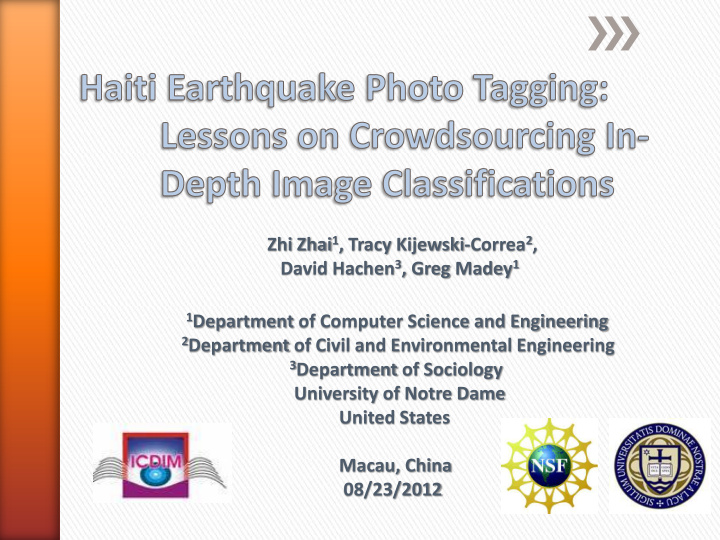



Zhi Zhai 1 , Tracy Kijewski-Correa 2 , David Hachen 3 , Greg Madey 1 1 Department of Computer Science and Engineering 2 Department of Civil and Environmental Engineering 3 Department of Sociology University of Notre Dame United States Macau, China 08/23/2012
2
» “Cognitive Surplus”: Advances of Modern Technologies I. More Free Time II. A Large Proportion Not Used Meaningfully Watching TV, Talking on the Phone, Online Chatting, etc. » The Development of Information Technology. - A better means to organize a large number of virtually connected people to effectively work together. 3
4
5
6
7
Haiti Haiti: A country in the Caribbean Sea Population: 9,719,932 Area: 10,714 mi 2 2010 Haiti Earthquake: 8 Time: Jan. 12, 2010 Magnitude: 7.0 Casualties: 316,000 Deaths
9
10
» Background: 2010 Haiti Earthquake » Thousands of Photos Taken on Site » 242 Citizen Engineers Participated College Students as Surrogates » 9318 Photo Classifications on 400 Sample Photos Over 17 days 11 11
» Goal: Achieve highly trustworthy classifications from a large number of user inputs » Challenges: Diversified user backgrounds Potential malicious users Large data size 12
13
Column Beam Slab Wall
15
16
18
19
20
21
» Various Data Cleaning Approaches We focused on two of them: I. Free Loader Trimming II. Long Invalid Sequence 22
Average Time: 35-40 secs./photo Freeloaders: less than 10 secs./photo 23 Very Suspicious Data Points
» 3 PhD graduate students in civil engineering provided expert judgments on the 400 sample photos. 24
» Accuracy significantly increased after data pruning. » Clear shot photos: the crowd generate highly trustworthy results » Difficult ones (ambiguous objects or multiple tagging targets): less stratifying results 25
26
27
» Which aspects have the highest priority? Quality Cost Efficiency » Teamwork: currently, most current platforms, including our photo tagging system, do not support teamwork. How can we team up users to achieve higher productivity?
» A whole spectrum of citizen engineers with variable backgrounds and expertise. » Our preliminary research focuses on low-end average citizen engineers and high-end expert engineers. » How about the ones in between? How to foster junior engineers to be able to fulfill complicated tasks ? 29
30
& Acknowledgements: The research presented was supported in part by an award from the National Science Foundation, under Grant No. CBET-0941565. We would also like to thank Drs. Jenny Vaydich and Zack Kertcher for valuable contributions. 31
32
33
» Some users selected “Cannot Determine” as a shortcut to artificially increase the number of photo classifications in order to win prizes. » These behaviors introduced unreliable data points to the data set. 36
37 » The length of suspicious sequences becomes an Indicator of Data Quality
» Intraclass Correlation Coefficient ICC : A descriptive statistic to measure the similarity between data entries. » Crowd Consensus Score Comparing crowd consensus with the ground truth Ground Truth: Opinions of 3 Professionals from the Department of Civil Engineering 38
39
» Blending objective questions with subjective ones. » Measuring users’ confidence level » Providing users stronger motivation I. Monetary Rewards: basic salary + extra bonus II. Moral Encouragements: honor list, social media recognitions thank-you letters/notes from the local community in Haiti. 40
Recommend
More recommend